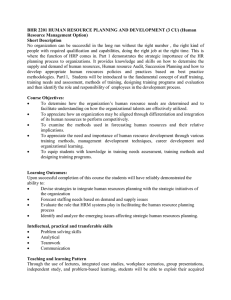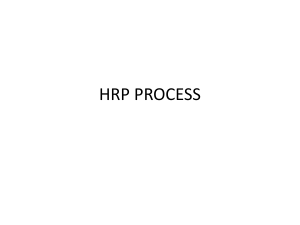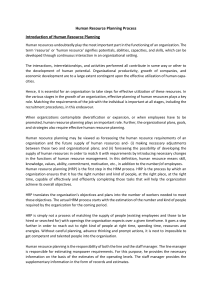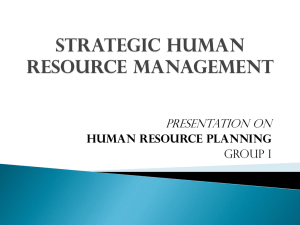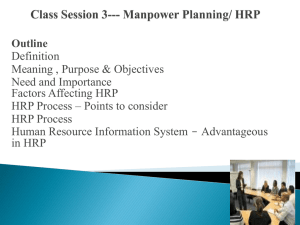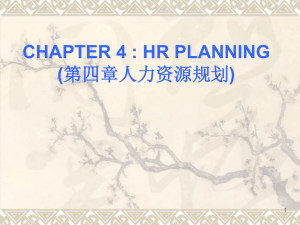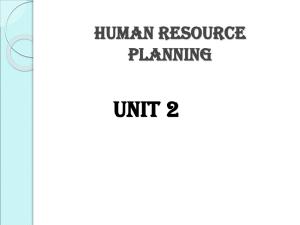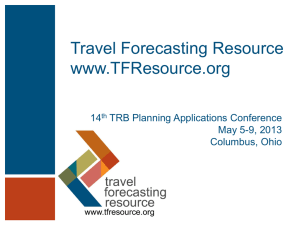Human Resource Planning
advertisement
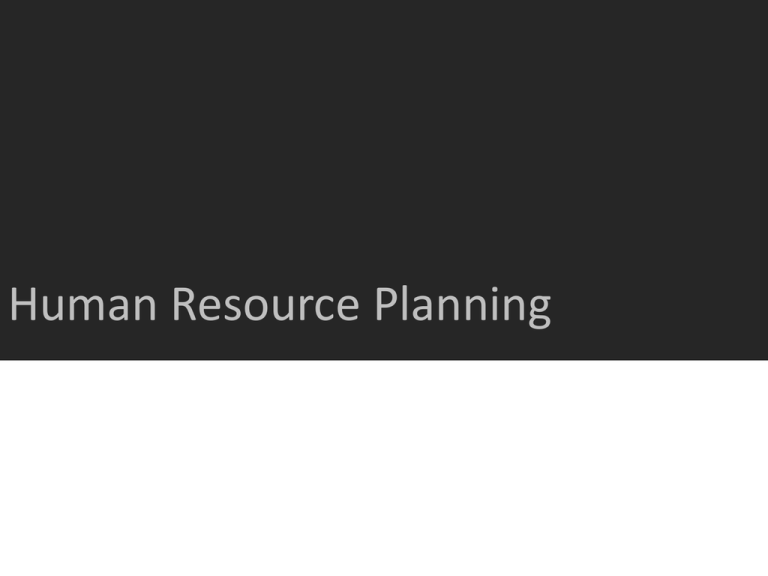
Human Resource Planning HRP defined • According to Coleman “it is the process of determining manpower requirements and the means for meeting those requirements in order to carry out the integrated plan of the organization” • Strainer defines it as “a strategy for the acquisition, utilization, improvement, and presentation of an enterprise’s human resources” Objectives of HRP • To ensure adequate supply of manpower • Ensure proper use of existing human resources • Forecast future requirements of human resources with different levels of skills • Assess surplus or shortage, if any, of human resources available over a period of time • Anticipate the impact of technology on jobs • Control the human resources already deployed in the organization • Provide lead time available to select and train the required additional human resources Need for HRP • Despite unemployment, there has been a shortage of human resources with required skills, qualifications and capabilities • Employees who retire, die, leave organizations or become incapacitated, need to be replaced by new employees • It is also essential in the force of marked rise in workforce turnover which is unavoidable • It is needed in order to meet the needs of expansion and diversification programmes • Technological changes and globalization usher in change in method of production which may require a change in the skills of the employees HRP Process • Organizational environment scanning • Formulation of HR objectives and policies • Demand forecasting • Supply forecasting • HR programming • HRP implementation • HRP controlling and evaluation Demand forecasting techniques – Ratio Trend Analysis • Refers to the technique under which ratios are calculated (e.g., total output/total number of workers, total sales volume/ number of sales persons) • Example, Units produced in 2005-06 = 10,000 Number of workers in2005-06 = 500 Ratio = 500 : 10,000 = 1:20 Estimated production in 2007-08 = 25,000 Number of workers required in 2007-08 = Estimated production x Ratio Number of workers required in 2007- 08 = 25000 x 1/20 = 1250 Demand forecasting techniques – Regression Analysis • In this technique, regression equations are formed and solves with the help of different software • It is used to forecast the future workforce demand based on factors such as sales, output, profit, productivity and existing number of employees – Bureks – Smith Model • Mathematical model based on selected key variables that influence the overall workforce needs En = [(Lagg + G) 1/X] Y Where, En = Estimated human resource demand n = Planning period Lagg = Overall turnover or aggregate level of business activity in Rupees G = Total growth in business activity during period n X = Average improvement in productivity Y = Conversion figure that relates the present overall activity to the human resource needed Demand forecasting techniques – Work Study Technique • It is used in cases where it is possible to measure the work to determine the duration of the operations and the number of employees required • It estimates the required number of employees possessing desirable skill sets to accomplish the total production targets • Example, Planned output for the next year = 25,000 units Standard hours per unit = 4 hours Planned hours required for the work = 25,000 X 4 = 1,00,000 Productive hours per worker per year = 2,000 Number of workers required = 1,00,000/2,000 = 50 Demand forecasting techniques – Management Judgment or Managerial Judgment • Managers sit together and discuss their future work assignments and tasks, and estimates how many people they need • It can be either ‘bottom-up’ or ‘top-down’ • In case of bottom-up approach, line managers prepare departmental requirements for human resource and submit it to top managers for their review • In the top-down approach, the top managers prepare the departmental forecasts which are reviewed with the departmental heads or managers – Expert opinion • Refers to the technique based on the executive or expert decisions provided by the different departmental heads or other knowledgeable persons • The judgmental views of experts are collected to produce a forecast about the future manpower demand Demand forecasting techniques – Group Brainstorming • Involves face-to-face discussion on various issues by experts who make some assumptions about the future course of action for the business • Experts first examine the strategic plans of the organization and then try to predict the future demand of employees – Nominal Group Technique (NGT) • A problem or issue is presented to the group and each member of the group individually produces as many solutions as possible • All generated answers are presented to the group for clarification • The group proposes the most feasible and realistic solutions based on the clarifications Demand forecasting techniques – Delphi Technique • A series of questions is individually asked to a jury of experts about their perceptions of future events. • In this technique, the direct interaction among the members is avoided • It involves the use of questionnaires and the results are fed back to the group members so that they can come to a consensus • This method is however, very time consuming Supply forecasting techniques – Markov Analysis or Flow Models • Uses historical flow rates of workforce to predict future rates • The flow of workforce over years within the organization is shown by means of probabilities • The probability of how many existing employees would be retained, transferred, promoted, terminated, resigned and demoted is estimated • Thereafter, future workforce flows are estimated based on the present data – Turnover Analysis • Examines the attrition rate and its historical trends in detail • The information for the analysis is gathered from exit interviews and labour turnover rates are calculated from the past data • The turnover rates are estimated for each job category, department and division Supply forecasting techniques – Goal Programming • The desirable employment pattern is estimated considering various potential constraints, such as total salary budget and limit of the new employees that can be recruited – Skill Inventory • Refers to the technique in which skills, knowledge, abilities, expertise and career aspirations of present pool of human resource is assessed • The existing skill inventory should be updated every two years to incorporate the changes Supply forecasting techniques – Succession Planning • Involves the preparation of an inventory report of executives representing which candidates are prepared to be promoted to the higher managerial level positions in the organization – Replacement Chart • Refers to the short-term replacement schedules that map the possible substitution of the employees within the hierarchy of the organization • Can be used in predicting internal supply, especially for the managerial positions HR programming • This step deals with the reconciliation of demand and supply • It is also termed as Human Resource Gap Analysis • It provides the basis for preparing Human Resource plans by eliminating the gap between the demand and supply of human resource If shortage of employees is expected • Hire new full time employees • Offer incentives for postponing retirement • Re-hire retired employees on part-time basis • Attempt to reduce turnover • Overtime for present staff • Sub-contract work to another company • Hire temporary employees If a surplus of employees is expected • Incentives for early retirement • Transfer/ redeployment by placing employees in another branch or department • Retrenchment /Lay-off • Do not replace employees who leave the organization with new ones’ • Outplacement • Use slack time for employee training HRP Implementation and Controlling and Evaluation • HRP implementation involves the execution of HR plans • The last step involves monitoring and controlling of HR plans to ensure their proper execution • HR plans should be developed considering the budget, time limits, targets and established standards
